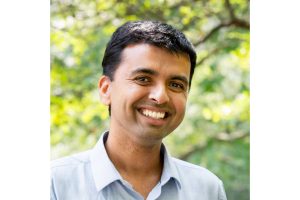Join us as we host Arvind Murugan from the University of Chicago’s Department of Physics for his talk, “Materials With Physically Learned Phase Diagrams.” Catch it on Wednesday, April 16th at 3pm in Maryland Hall room 110.
Abstract: Materials With Physically Learned Phase Diagrams
Materials are typically designed to have one fixed behavior through an optimal choice of parameters at the time of synthesis. We propose an alternative learning framework for a learning material in which molecular interactions adapt via a molecular Hebbian principle: “get together, grow to like each other.” In multicomponent systems, this Hebbian learning can position phase boundaries within a phase diagram so that the material can compute and deploy specific responses to distinct high-dimensional molecular inputs. In this way, these learned phase boundaries function as decision boundaries for high-dimensional inputs, offering an alternative route to neural computation without neurons in material systems. Our theory and experiments show that these ideas enable diverse molecular systems —such as self-assembly, dimerization networks and phase separation — to learn associations and correctly respond to complex chemical patterns.
Bio: Arvind Murugan
Arvind Murugan obtained a BS in mathematics from the California Institute of Technology. He earned his PhD in high energy physics from Princeton University. He then transitioned to working on problems at the intersection of biology, theoretical computer science and statistical physics at the Institute for Advanced Study and the John A. Paulson School of Engineering and Applied Sciences at Harvard University. He joined the physics faculty at the University of Chicago in the fall of 2015. The major thrust of his research is how physical systems can learn from their environmental history and manifest neural network-like behavior. His current work focuses on learning in molecular self-assembly and mechanical systems. On the biological side, his group works on the evolution of molecular error correction. He was a Simons Investigator in the Mathematical Modeling of Living Systems and an NSF CAREER awardee.
